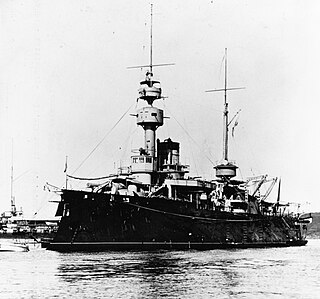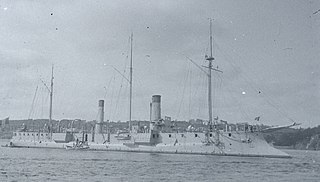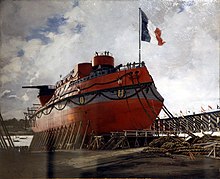
The Dévastation was an Dévastation-class ironclad battleship of the French Navy of central battery (casemate) design. She was used as a school ship for manoeuvres.

Courbet was an Dévastation-class ironclad central battery battleship of the French Navy.

Formidable was an ironclad barbette ship built for the French Navy between her keel laying in late 1879 and her completion in early 1889. She was the second and final member of the Amiral Baudin class. The ships of the class was designed in response to Italian naval expansion, and carried a main battery of three 370 mm (14.6 in) guns all mounted in open barbettes on the centerline. The armament was chosen after public pressure to compete with the very large guns mounted on the latest Italian ironclads.

Magenta was an ironclad barbette ship of the French Navy built in the 1880s and early 1890s. She was the third and final member of the Marceau class. The Marceau class was based on the earlier Amiral Baudin class of barbette ships, but with smaller guns: four 340 mm (13.4 in) weapons compared to the three 420 mm (16.5 in) guns of the earlier vessels. The ships introduced the lozenge arrangement for their main battery that became common for many French capital ships built in the 1890s. Magenta and her sister ships suffered from a number of problems, including poor stability, insufficient armor protection, and excessive displacement.

The Amiral Baudin class was a type of ironclad barbette ship of the French Navy built in the late 1870s and late 1880s. The class comprised two ships: Amiral Baudin and Formidable. After the Italian Navy began building a series of very large ironclads in the mid-1870s, public pressure on the French naval command to respond in kind prompted the design for the Amiral Baudin class. New, very large guns were developed to counter the weapons carried by the Italian ships; Amiral Baudin and Formidable were equipped with a main battery of three 370 mm (14.6 in) guns in three open barbettes, all on the centerline. Begun in 1879, work on the ships proceeded slowly and they were not finished until 1888–1889, shortly before the first pre-dreadnought battleships began to be built, which rendered older ironclads like the Amiral Baudin class obsolete.

The Marceau class was group of three of ironclad barbette ships of the French Navy built in the 1880s and early 1890s. The class comprised Marceau, the lead ship, Neptune, and Magenta; a fourth member of the class, Hoche was substantially re-designed after defects in the original plans for the class could not be rectified. The ships were based on the earlier Amiral Baudin class of barbette ships, but with smaller guns: four 340 mm (13.4 in) weapons compared to the three 420 mm (16.5 in) guns of the earlier vessels. They introduced the lozenge arrangement for their main battery that became common for many French capital ships built in the 1890s. Continuous tinkering with the Marceau design during their long construction produced badly flawed vessels that were superseded by more powerful pre-dreadnought battleships almost immediately after the French commissioned them in the early 1890s.

Marceau was an ironclad barbette ship built for the French Navy during the 1880s, the lead ship of her class. She served in the Mediterranean Squadron until 1900, when she was rebuilt and subsequently placed in reserve. She returned to service in 1906 as a torpedo training ship. During World War I, she served in Malta and Corfu as a submarine tender. The old ironclad was sold for scrapping in 1920, and while being towed to Toulon, she ran aground in a gale off Bizerte and became stranded. The wreck remained visible there until the 1930s.

Neptune was an ironclad barbette ship of the French Navy built in the 1880s and early 1890s. She was the second member of the Marceau class, which included two other vessels. The Marceau class was based on the earlier Amiral Baudin class of barbette ships, but with smaller guns: four 340 mm (13.4 in) weapons compared to the three 420 mm (16.5 in) guns of the earlier vessels. They introduced the lozenge arrangement for their main battery that became common for many French capital ships built in the 1890s. Neptune and her sister ships suffered from a number of problems, including poor stability, insufficient armor protection, and excessive displacement.

Amiral Baudin was an ironclad barbette ship of the French Navy built in the late 1870s and 1880s. She was the lead ship of the Amiral Baudin class, which included one other vessel, Formidable. The Amiral Baudin class was designed in response to Italian naval expansion, and carried a main battery of three 370 mm (14.6 in) guns all mounted in open barbettes on the centerline. The armament was chosen after public pressure to compete with the very large guns mounted on the latest Italian ironclads. Amiral Baudin was laid down in 1879 and was completed in 1888.

Amiral Duperré was an ironclad barbette ship built for the French Navy in the 1870s and 1880s; she was the first vessel of that type built by France. She carried her main battery of four 34 cm (13.4 in) guns individually in open barbette mountings, which offered increased fields of fire compared to earlier central battery ships, though they were less well protected. Amiral Duperré was ordered as part of a French naval construction program aimed at countering the growth of the Italian fleet, which had begun work on the very large ironclads of the Duilio and Italia classes in the early 1870s. The Italian vessels, armed with 45 cm (17.7 in) guns, prompted public outcry in France that pressured the navy to develop larger guns for its own ships. Amiral Duperré's design served as the basis for several follow-on classes, including the Bayard and Amiral Baudin classes.

Bayard was the lead ship of the Bayard class of ironclad barbette ships built for the French Navy in the late 1870s and 1880s. Intended for service in the French colonial empire, she was designed as a "station ironclad", smaller versions of the first-rate vessels built for the main fleet. The Vauban class was a scaled down variant of Amiral Duperré. They carried their main battery of four 240 mm (9.4 in) guns in open barbettes, two forward side-by-side and the other two aft on the nautical. Bayard was laid down in 1876 and was commissioned in 1882.

Milan was a late-19th-century unprotected cruiser in the French Navy. At the time of her completion, Milan was considered by several publications to be the fastest warship in the world. The warship was the last unprotected cruiser in French naval service, and Milan's design influenced the construction of later protected cruisers.

Terrible was an ironclad barbette ship built for the French Navy in the late 1870s and early 1880s. She was the lead ship of the Terrible class, which included three other vessels. They were built as part of a fleet plan started in 1872, which by the late 1870s had been directed against a strengthening Italian fleet. The ships were intended for coastal operations, and as such had a shallow draft and a low freeboard, which greatly hampered their seakeeping and thus reduced their ability to be usefully employed after entering service. Armament consisted of a pair of 420 mm (16.5 in) guns in individual barbettes, the largest gun ever mounted on a French capital ship. Terrible was laid down in 1877 and was completed in 1887.

Requin was an ironclad barbette ship built for the French Navy in the late 1870s and early 1880s. She was last member of the four-ship Terrible class. They were built as part of a fleet plan started in 1872, which by the late 1870s had been directed against a strengthening Italian fleet. The ships were intended for coastal operations, and as such had a shallow draft and a low freeboard, which greatly hampered their seakeeping and thus reduced their ability to be usefully employed outside of coastal operations after entering service. Armament consisted of a pair of 420 mm (16.5 in) guns in individual barbettes, the largest-caliber gun ever mounted on a French capital ship. Requin was laid down in 1878 and was completed in 1887.

Indomptable was an ironclad barbette ship built for the French Navy in the late 1870s and early 1880s. She was second member of the Terrible class, which included three other vessels. They were built as part of a fleet plan started in 1872, which by the late 1870s had been directed against a strengthening Italian fleet. The ships were intended for coastal operations, and as such had a shallow draft and a low freeboard, which greatly hampered their seakeeping and thus reduced their ability to be usefully employed after entering service. The main armament consisted of two 420 mm (16.5 in) guns, one fore and one aft, mounted in barbettes—the largest gun ever mounted on a French capital ship. Indomptable was laid down in 1878 and was completed in 1887.

Caïman was an ironclad barbette ship built for the French Navy in the late 1870s and early 1880s. She was the third of four ships of the Terrible class, built as part of a fleet plan started in 1872, which by the late 1870s had been directed against a strengthening Italian fleet. The ships were intended for coastal operations, and as such had a shallow draft and a low freeboard, which greatly hampered their seakeeping and thus reduced their ability to be usefully employed after entering service. Armament consisted of a pair of 420 mm (16.5 in) guns in individual barbettes, the largest gun ever mounted on a French capital ship. Caïman was laid down in 1878 and was completed in 1887.

Vauban was the lead ship of the Vauban class of ironclad barbette ships built for the French Navy in the late 1870s and 1880s. Intended for service in the French colonial empire, she was designed as a "station ironclad", smaller versions of the first-rate vessels built for the main fleet. The Vauban class was a scaled down variant of Amiral Duperré. They carried their main battery of four 240 mm (9.4 in) guns in open barbettes, two forward side-by-side and the other two aft on the nautical. Vauban was laid down in 1879 and was completed in 1885.

Duguesclin was an ironclad barbette ship built for the French Navy in the late 1870s and 1880s; she was the second and final member of the Vauban class. Intended for service in the French colonial empire, she was designed as a "station ironclad", which were smaller versions of the first-rate vessels built for the main fleet. The Vauban class was a scaled down variant of Amiral Duperré. They carried their main battery of four 240 mm (9.4 in) guns in open barbettes, two forward side-by-side and the other two aft on the centerline. Duguesclin was laid down in 1879 and was completed in 1885. Despite the intention to use her overseas, the ship remained in home waters for the duration of her career, serving with the Mediterranean Squadron from 1888 to 1895, though the last two years were as part of the Reserve Division. She spent the next several years in the 2nd category of reserve, ultimately being struck from the naval register in 1904. She was sold for scrap the following year and broken up in Italy.

Surcouf was the second Forbin-class protected cruiser built for the French Navy in the late 1880s and early 1890s. The Forbin-class cruisers were built as part of a construction program intended to provide scouts for the main battle fleet. They were based on the earlier unprotected cruiser Milan, with the addition of an armor deck to improve their usefulness in battle. They had a high top speed for the time, at around 20 knots, and they carried a main battery of four 138 mm (5.4 in) guns.

Lalande was a protected cruiser of the Troude class built for the French Navy in the late 1880s and early 1890s. The class was built as part of a construction program intended to provide scouts for the main battle fleet. They were based on the preceding Forbin class, the primary improvement being the addition of armor to the conning tower. Lalande was built in the 1880s and was completed in late 1890. She was armed with a main battery of four 138 mm (5.4 in) guns, protected with an armor deck that was 41 mm (1.6 in) thick, and had a top speed of 20.5 knots.






















